Taekwondo
History
Taekwondo is modern martial arts. Korea is the founder of Taekwondo. Taekwondo is art of foot and fist. Taekwondo is not only sport but is an art of self defence also. It is needful for the children and young gentian. Taekwondo mean:- Tae - foot (Kick) Kwon - fist (Punch) Do - way/method (Art) Taekwondo means that the use of foot and fist as weapon or the art of kicking and punching. The art of mixing poomase, discipline, sparring, self-defence and breaktest. Taekwondo in modern time.
- It is known for the self-defence and as a sport.
- To keep body fit and healthy.
- For the self-defence of every boy/girl and children.
There is no limit of age to learn of Taekwondo. A kid, who can understand, can learn this art. The children it as a sport then an art of self-defence. During Taekwondo sport the security of children is kept in mind. Safety guard are provide to players. Head guard for head, chest guard for chest are provided. There are two type of competitions of Taekwondo, ITF - semi contact and WTF- full contact. Taekwondo is apart of International Olympic Association. It means this sport has every facility like other sports. Martial arts started by bhikshus and negree's in jungle. Bhikshus had no permission for keep weapon negree's had no weapons to defenced them selevs, so they started martial arts for his defence. They started using there hand and foot as vepan. The art of self-defence for example karate, kung-fu, Taekwondo etc. came and to reason. Because the Korea was the founder of Taekwondo and according to Koreans, The earliest records of martial arts practice in Korea date back to 50 B.C. These earliest forms of Korean martial arts are known as 'Taekkyon'. Evidence that martial arts were being practiced at that time can be found in tombs where wall-paintings show two men in fighting stance .Others reject this evidence and say that these men could be simply dancing. Back then, time there were three kingdoms:1.Koguryo(37 B.C.-668 A.D.)2.Paekje(18 B.C.-600 A.D.)3.Silla(57 B.C.-935 A.D.)Silla unified the kingdoms after winning the war against Paekje in 660 A.D.and Koguryo in 668 A.D.The Hwa Rang Do played an important role at this unification. The Hwa Rang Do was an elite group of young noble men, devoted to cultivating mind body and serve the kingdom Silla.The best translation for Hwa Rang would probably be "flowering youth"(Hwa-"flower", Rang -"young man").The Hwa Do had an honor-code and practiced various forms of martial arts,including Taekyon and Soo Bakh Do. The old honor-code of the Hwa Rang is the philophical background of modern Taekwondo.
What followed was a time of peace and the Hwa Rang turned from a military organization to a group specialized in poetry and music. It was in 936 A.D. when Wang Kon founded the Koryo dynasty, an abbreviation of Koguryo.The name Korea is derived from Koryo. During the Koryo Dynasty the sport Soo Bakh Do,which was then used as a military training method, become popular. During the Joseon-dynasty(also known as the Yi-dynasty.1392A.D.-1910A.D.) this emphasis on military training disappeared. King Taejo, founder of the Joseon-dynasty ,replaced Buddhism by Confucianism as the state religion. According to Confucianism, the higher class should study the poets, read poems and play music. Martial arts were something for the common or even inferior, man. After World War II, when Korea become independent, several kwans arose. These kwans were:
The Kwans united in 1955 as Tae Soo Do. In the beginning of 1957, the name Taekwondo was adopted by several Korean martial arts masters, for its similarity to the name Tae Kyon. General Choi Hong Hi was training his soldier by this art in Korean army, so the very first Taekwondo students were Korean soldiers. General Choi established International Taekwondo Federation and demonstrated this art in different countries and brought in to fame .Then Korea Taekwondo Association was established in 1965 and General Choi Hong Hi was appointed president .Kukkiwon established in 1972 and World Taekwondo Federation was formed in 1973. In 1988 WTF Taekwondo was first staged at the Seoul Olympic as a demonstration sport, again in 1992 in Barcelona and installed as an official sport in 2000 at the Sydney Olympic.
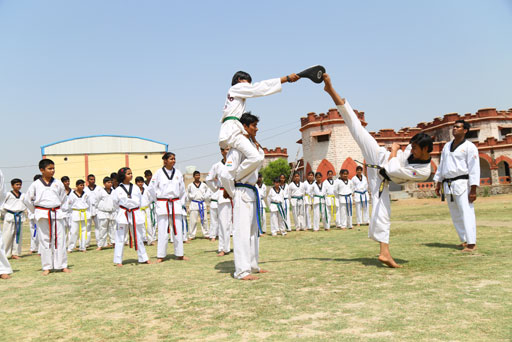
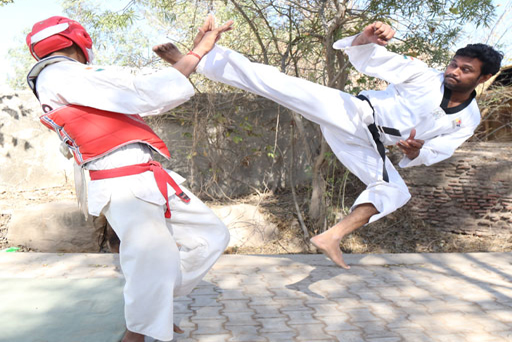
Rule & Regulations
Arena
2.) The four corner’s of Arena (#1, #2, #3, #4) is of length 10m x 10m & The Competition Area shall have a flat surface without any obstructing projections, and be covered with an elastic mat. 2. The position of the Referee shall be marked at a point 1.5m back from the center point of the Contest Area.3. The position of the Contestants shall be marked at two opposing points, 1m from the center point of the Competition Area, 5m from Boundary Line #1 (red Contestant toward Boundary Line #2 and blue Contestant toward #4). 4. 3.The side back up coach/senior chair is 1 meter ahead from the arena bounder line’s center point of each contestant’s side.
Arena
2.) Field of Taekwondo Play 2. Competition Area 3. Boundary 4. 1. 1st Boundary Line & 2nd , 3rd & 4th Boundary line clockwise 1. Referee’s Mark 2. Judge’s Mark 3. Recorder’s Mark 4. Commission Doctor’s mark 5.-1. Blue Contestant’s mark 5-2. Red Contestant’s mark 6-1. Blue Coach’s mark 6-2. Red Coach’s mark.
Uniforms and Protect Guard
In competition, a Taekwondo athlete wears a white-neck uniform called “Dobok.”the style of the Dobok is based on traditional Korean peasant garb. All contestants compete barefoot. For protection, competitors must wear a red or blue chest protector, headgear, shin, hand gloze, foream guards and mouthpieces. Male player must also wear a groin-area guard. The headgear s worn mostly to protect against injury to an unconscious player falling to the mat, and the forearm and shin guard are to prevent nerve damage to the designated area.
Referee
1. A Black Pant.2. A White Shirt.3. A Black Tie & Allowed sports shoes only The referee shall have control over the match & the position of the Referee shall be marked at a point 1.5m back from the center point of the Contest Area.
1. The position of the Referee shall be marked at a point 1.5m back from the center point of the Contest Area.2. (1) The referee shall have control over the match3. The referee shall declare “Shi-jak”, “Keu-man”, “Kal-yeo”, “Kye-sok” and “Kye-shi”, winner and loser, deduction of points, warnings and retiring. All the referees’ declarations shall be made when the results are confirmed.4. The referee shall have the right to make decisions independently in accordance with the prescribed rules.5. The referee shall not award points.6. In case of a tie or scoreless match the decision of superiority shall be made by all refereeing officials after the end of the fourth round.
Corner Judges
1. Judges have same Referee's Dress.
2. Four corners judge are in Taekwondo but this time only two corner3. The judges shall mark the valid points immediately.4. The position of the 1st Judge shall be marked at a point 0.5m from the corner of boundary line #1 & #4.
Others Position
1. The position of the Chief Jury (chief judge) & Recorder shall be marked at a point 2m back from boundary line #1 facing the Competition Area with one Announcer/ One Tie’s maker/ One time Keeper etc2. The position of the Commission Doctor shall be marked at a point more than 3m to the right side from the Boundary Line.3. The position of the Coaches shall be marked at a point 1m away from the center point of the Boundary Line of each contestant’s side.
Rules of TAEKWONDO Competition in Arena
Center Referee’s decision last decision of fight according to rulers.
1. Two corners of two sides of arena on the both side of referees.2. Red corner means Hong on left side.3. Blue corner means Chung on right side of center referee.After Announcing the names of players center referee start the fight, standing on the center line in the arena calling Chung & Hong by hand appoints. 1. Bow (Wish) on the front side on the side of judge at the Korean command of Referee “Cha-ryeot”[attention] & “Kyeong-rye”[bow].2. At the time of fight first of all center Referee check the dress and guards of Player, Nails, any article like bangles, ring, locket, etc are not allowed. Grownguard is compulsory for boys.3. Calling of Position of Starting the fight says “Joon-bi” [ready] 4. To start the fight calling “Shi-jak”[start].5. To stop the fight calling ‘Kal-yeo’ (stop) by the referee.6. In case of time cutting or any demand of player to stop the fight the time period is calling khasik or time cut with crossing of first fingers of both side.7. To start again the fight is calling “Shi-jak”[start] or time start with breaking of cross of first finger of both hands.8. After visual the center Referee & reaches to judges table. After discuss give pointing of both side by hand finger.9. After the IInd time period again fight is start by same words & rules.10. After the end of the last round, the contestants shall stand at their respective positions facing each other and exchange a standing bow at the referee’s command of “Cha-ryeot”, “Kyeong-rye”, and then wait for the referee’s declaration of the decision in a standing posture.11. The referee shall declare the winner by raising his/her own hand to the winner’s side.
Objective
Because the definition of Taekwondo “the way of the hand and foot”. Each player tries to earn points by landing kicks to the face and body, or punches to the body.1. A men’s match consists of three rounds of three minutes each with a one minute rest period between rounds. A women’s match consists of three rounds of two minutes, with one minutes rest period between round & Fight round is 1/2 minute depending upon conditions & Committee.2. With starting of fight round & end of fight round time keeper kept Visual.3. 1/2/3 rounds of fight depending upon the conditions & committee to Tie’s.4. In condition of have only one player in one weight group gave winner according to the rule of by/walkover.5. Normally 3 rounds are happened. The winner is given according to point system.6. In case of points remains equal with round will be happened, first point is winner. The juries & centre referee decision is last decision.
Fules & Warnins,Point Cut Given By Center Referee
Center Referee give warning of lower attack, Griping, pushing of arena tine, articles, speaking, laughing etc by calling "Gam-jeom" (deduction). If a player unintentionally crosses the boundary line, the referee will declare “Joo-eui” or a verbal warning. The second time this ocure,”Gam-jeom” means half point penalty is declared. Arm appoints below the solder after giving “Gam-jeom” means foul (warning)-means half point penalty. Two “Gam-jeom” means one point cut.
a. Crossing the Boundary Lineb. Evading by turning the back to the opponentc. Falling down d. Avoiding the match e. Attacking below the waistf. Butting or attacking with kneeg. Hitting the opponent’s face with the handh. Uttering undesirable remarks or any misconduct on the part of a contestant or a coachi. Laughing, Speaking is fouls in fight.j. Lower attack is foul.k. Any metal article & longer nails are fouls.l. Face Punch is foul.m. Griping, Pushing is foul.n. In condition of shouting or hooting by the player team is prohibited & disqualification of that player.
Deduction "Gam-jeom"
After "Gam-jeom" appoint above the shoulder by hand means one point cut depends upon the finger raising the center Referee.a. Attacking the opponent after `Kal-yeo’ b. Attacking the fallen opponent c. Throwing down the opponent by grappling the opponent’s attacking foot in the air with the arm or by pushing the opponent with the handd. Intentionally attacking the opponent’s face with the hand e. Interrupting the progress of the match on the part of a contestant or a coach f. Violent or extreme remarks or behavior on the part of a contestant or a coachWhen a contestant intentionally refuses to comply with the Competition Rules or the referee's order, the referee may declare the contestant loser by penalty after one (1) minute. When a contestant receives minus four [-4] points, the referee shall declare him/her loser by penalties. "Gam-jeom" and " Gam-jeom" shall be counted in the total score of the three rounds.
Points
Points are available only on the front of body above the belt mark.1) Mid-section of the trunk: The part covered by the trunk protector 2) Face: The whole part of the face including both ears.Points shall be awarded when permitted techniques are delivered accurately and powerfully to the legal scoring areas of the body. The Valid Points: 1) One (1) point for attack on trunk protector2) Two (2) points for attack on face. 3) One (1) additional point shall be awarded in the event that the contestant is knocked down and the referee counts.
Determining The Winner
Most matches are won and lost on the scoreboard, the player who tallies the most points (less deduction) is the winner. Other means of determining a winner include:-• superiority (SUP) other than in the final, if competitors are tied after three rounds, victory goes to whichever player scored more points (penalties are ignored).if the tie remains, the judges determine the winner based on initiative shown during the match.• Default (if the opponent earns four penalty points)• Referee stopped contest (RSC)• Knockout (KO)• Disqualification (DQ)• Tiebreaker system in final match-If a tie occurs in the gold medal match, superiority is not initially used to determine the winner. Instead, the two competitors will go into a fourth, sudden death round, with whoever scores the next point being declared the winner. If neither player scores a point in the extra round, the referee will decide the winner based on who superior in the round.
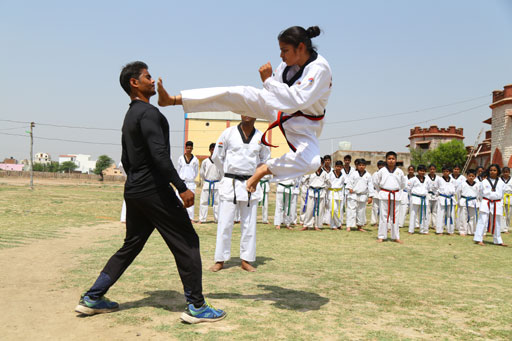
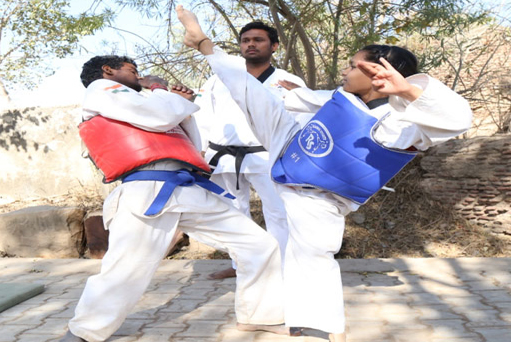
Affiliation
Affiliated with Taekwondo Board of India
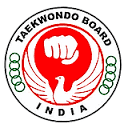
Success Player